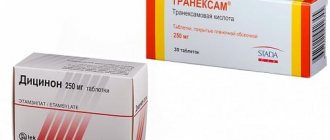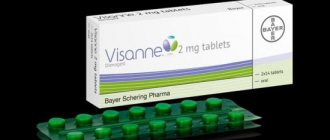Causes of uterine bleeding
When the hormonal system malfunctions, incomplete rejection of the main layer of the endometrium occurs. As a result, the dilated glands, blood vessels and the inner mucous membrane of the uterus bleed. This is a dangerous symptom that indicates the presence of a disease.
The condition of the female genital organs is normal
There are many reasons leading to hormone imbalance. Conventionally, they are divided into:
- genital, associated with pregnancy;
- genital, unrelated to pregnancy;
- non-genital.
Nongenital causes are a combination of factors that can cause bleeding from the uterus due to diseases not related to the reproductive system:
- Various types of infections:
- flu;
- ARVI;
- measles;
- blood poisoning;
- typhoid fever.
- Diseases of the circulatory system:
- hemorrhagic vasculitis;
- vitamin deficiency;
- hemophilia.
- Cirrhosis of the liver.
- Reduced functionality of the thyroid gland.
- Diseases of the heart and blood vessels:
- hypertension;
- atherosclerosis;
- myocardial infarction.
The manifestation of any symptoms of uterine bleeding is the reason for emergency consultation with a doctor.
During pregnancy, uterine bleeding often occurs due to the following reasons:
- Ectopic pregnancy.
- Uterine pregnancy occurring with pathologies:
- scars on the walls of the uterus;
- premature placental abruption;
- tissue destruction;
- miscarriage;
- placenta previa.
- Birth and postpartum pathologies:
- uterine rupture;
- trauma to the vagina and birth canal;
- delayed release of placenta;
- endometritis.
- Disease of the ovum:
- hydatidiform mole;
- chorionepithelioma (cancer tumor).
But most often, uterine bleeding occurs due to genitourinary diseases and conditions not directly related to pregnancy and childbirth. The main factors for such bleeding are:
- Discirculatory bleeding from the uterus (caused by a malfunction of the ovaries):
- juvenile - during puberty at the age of 10 to 18 years;
- reproductive - during puberty of women aged 18 to 40 years;
- menopause in women over 40 years of age.
- Tumors of various etiologies (malignant and benign):
- uterus;
- ovaries.
- Ovarian ruptures and/or cysts.
- Injuries of the uterus and genitourinary tract.
- Infectious and inflammatory processes of the female genital organs:
- cervical erosion;
- endometriosis;
- vaginitis and vaginosis;
- cervicitis;
- endocervicosis.
If uterine bleeding occurs, you must contact a gynecologist as soon as possible. Having identified the real cause of the pathology, the doctor will prescribe appropriate treatment aimed at eliminating it.
Tranexam is the main remedy for stopping uterine bleeding
In complex therapy, an important place is given to medications that can stop the flow of blood from the uterus. Among the most effective medications is the hemostatic agent Tranexam.
The drug was developed by the Moscow Endocrine Plant. Production is carried out by domestic pharmaceutical enterprises:
- OJSC Nizhpharm;
- CJSC Obninsk Chemical and Pharmaceutical Plant.
The basis of the product is tranexamic acid (chemical name: trans-4-(Aminomethyl) cyclohexanecarboxylic acid - formula C8H15NO2). This is a synthetic analogue of lysine.
The substance has the following actions:
- hemostatic;
- anti-inflammatory;
- anti-infective;
- mild analgesic;
- antitumor;
- anti-allergic.
Forms of release of the drug
This medicine is produced in two pharmaceutical forms:
- coated tablets: 250 and 500 mg;
- solution for intravenous administration in ampoules of 5 mg.
Tranexam tablets are coated with a white, rapidly dissolving film coating.
The tablets are biconvex, with a transverse cut in the middle for breaking. Covered with a white, quick-dissolving film coating.
What does the drug contain, besides tranexamic acid?
Tablet Tranexam contains the following substances as auxiliary components:
- microcrystalline cellulose;
- talc;
- colloidal silicon dioxide;
- calcium stearate;
- modified starch.
The injection solution is used when there is a high risk of an inflammatory process against the background of heavy bleeding.
The solution for intravenous administration is a practically colorless and transparent liquid in glass ampoules. In addition to the active substance, the medicine includes ordinary water for injection as an auxiliary component.
Effect of the drug
The effectiveness of this drug is based on the properties of the active substance, which can quickly cope with even severe bleeding. Tranexam directly affects the blood clotting process by acting on fibrinolysin and converting it to plasmin (a component that provides coagulation). In this case, there is a decrease in the release of biological fluid from the organs.
Recommendations for use: how to take tablets when using injection solution
Tranexam is available in pharmacies strictly according to a prescription. You cannot self-medicate, as its improper use, without diagnosis and taking into account limitations and contraindications, can lead to disastrous results. This is especially true for intravenous administration of medication.
Only a doctor, after a thorough examination and tests, can prescribe a drug.
Before starting treatment, you should read the instructions for use of the drug
As a rule, the doctor prescribes Tranexam tablets to be taken 2-3 times a day, regardless of food intake. The duration of treatment is from 3 to 10 days.
If the doctor considers it necessary, then if there is a high risk of an inflammatory process against the background of heavy bleeding, an injection solution is used: drip or stream. Only intravenously.
Description of the drug Tranexam
The drug Tranexam is often used to treat uterine bleeding. It is used in therapy to reduce and restore the volume of menstruation, to stop bleeding and reduce the risk of miscarriage against the background of bleeding.
The main active ingredient of this medicine is tranexamic acid. It can influence fibrinolysin, a substance found in the blood that prevents it from clotting.
Pharmacological effect of the drug on the human body:
- local and systemic hemostatic (hemostatic);
- anti-inflammatory;
- antihistamine (anti-allergic);
- anti-infective;
- antitumor;
- analgesic (pain reliever).
For uterine bleeding, synthetic drugs are often prescribed that have a beneficial effect on the lining of the uterus. Such a drug is dicinone.
Its pharmacological properties include the following:
- the ability to activate the process of formation of thromboplastin protein;
- normalization of blood clotting
- prevents the formation of blood clots.
Dicynone is available in several forms: tablets, injections. This drug has proven its effectiveness in treating bleeding that is localized in small vessels. After taking dicinone (the dosage should be prescribed only by the attending physician), a woman will be able to feel the effect within a few hours. Repeated testing of this drug has shown that the highest results are achieved when taking tablets rather than intramuscular injections.
To stop uterine bleeding, experts use the following regimen: two ampoules of dicinone are administered intravenously (can be intramuscularly), after which this drug is prescribed in tablet form every six hours. In order to prevent bleeding, the patient should take this drug orally, starting from the 5th day of the menstrual cycle.
Tranexam is rightfully considered the first aid for uterine bleeding, since it is very quickly able to cope with this problem. This drug has a direct effect on the blood clotting process and directly affects plasminogen (inactive). Tranexam is now available in pharmacies, both in the form of tablets and in the form of injections (intramuscular).
If moderate blood loss is observed, then tablets will be sufficient. When determining the dosage, the doctor must take into account the patient’s weight and the severity of the disease. Tranexam is often prescribed to prevent uterine bleeding, especially when preparing patients for surgical procedures.
Vikasol is a synthetic medical drug that can replace vitamin K, which is important for women’s health and takes an active part in the production of prothrombin. In the absence or insufficient amount of this vitamin, women develop bleeding.
After taking Vikasol, patients experience relief only after 12-18 hours, which is why it is not used in emergency care. Despite this, many doctors often prescribe this drug in the complex treatment of uterine bleeding, as well as for preventive purposes. Vikasol is prescribed to pregnant women after the onset of the first contractions to prevent the development of bleeding, which may develop during the onset of the active phase of labor.
For menstrual bleeding, doctors often prescribe medications that can significantly reduce the volume of menstruation.
A great effect is achieved when taking etamsylate, which has extensive pharmacological properties:
- has the ability to stop bleeding;
- activates the processes responsible for blood clotting and the rate of platelet adhesion;
- increases the elasticity and stability of capillaries, etc.
While taking etamsylate, patients do not experience internal discomfort, since this drug has a smooth effect on the female body. In the process of conducting numerous studies, it was revealed that ethamsylate does not cause sudden blood clotting, which prevents the formation of blood clots.
When uterine bleeding develops, the first action of a specialist is to prescribe a drug to the woman that can quickly provide the necessary assistance. Oxytocin, which has a selective effect on the uterus, can stop blood loss.
After taking oxytocin, the female body experiences increased excitability of muscle fibers, against the background of which strong contractions begin. This drug can be prescribed both in tablet form and as intravenous injections.
Ascorutin, which has been actively used in gynecology for many years, can provide real help to women suffering from heavy periods, which often develop into uterine bleeding.
This medicine contains the following main components: vitamin P (rutin) and ascorbic acid. Its direct effect on the female body is to strengthen the walls of blood vessels, preventing fragility and permeability of capillaries.
With long-term use of ascorutin (the duration is determined by the attending physician), tissue regeneration occurs, and the protective functions of the female body are activated, capable of resisting any negative effects.
Restrictions and contraindications for use
There are a number of restrictions and contraindications for the use of the drug in the treatment of uterine bleeding.
Contraindications
The use of Tranexam is prohibited in the following cases:
- hypersensitivity to the constituent components of the drug, including the active substance;
- subarachnoid hemorrhage (intracerebral hemorrhage in the cavity between the arachnoid and pia mater, occurring when an arterial aneurysm ruptures or as a result of traumatic brain injury).
Restrictions
With extreme caution and under strict monitoring of the patient’s condition, the drug is used to stop uterine bleeding when the following diseases are detected:
- thrombosis of cerebral vessels;
- myocardial infarction;
- thrombophlebitis;
- color vision disorders;
- renal failure;
- thromboembolism;
- thrombohemorrhagic complications;
- hematuria (increased level of red blood cells in the urine);
- threat of development of the above diseases.
Features of use during pregnancy and lactation
There is a restriction for use during breastfeeding. Since the drug can penetrate into milk and negatively affect the child’s health, it is necessary to transfer the baby to artificial nutrition during the period of treatment of uterine bleeding with Tranexam.
Due to the fact that this remedy can prevent the obvious threat of spontaneous early labor (miscarriage), it is approved for use at any stage of pregnancy. However, a mandatory thorough examination of the woman is first required to exclude the presence of diseases that prohibit taking the drug.
Use for menopause
The prescription of Tranexam for uterine bleeding during menopause in women has no special restrictions, but only requires routine preliminary diagnostics that can exclude the presence of contraindications.
Comparison of addiction between Tranexam and Vikasol
Like safety, addiction also involves many factors that must be considered when evaluating a drug.
So, the totality of the values of such parameters as “o syndrome” in Tranexam is quite similar to the similar values in Vikasol. Withdrawal syndrome is a pathological condition that occurs after the cessation of intake of addictive or dependent substances into the body. And resistance is understood as initial immunity to a drug; in this it differs from addiction, when immunity to a drug develops over a certain period of time. The presence of resistance can only be stated if an attempt has been made to increase the dose of the drug to the maximum possible. At the same time, Tranexam has a fairly low incidence of “syndrome”, just like Vikasol.
Adverse reactions of the body to Tranexam and pharmaceutical incompatibility
If the drug dosage regimen is violated or under the influence of external factors, the development of adverse reactions cannot be ruled out.
When using tablet Tranexam, the following manifestations are possible:
- nausea, sometimes leading to vomiting;
- heartburn;
- flatulence;
- diarrhea;
- rashes;
- itching;
- drowsiness;
- dizziness;
- weakness in the body;
- lack of appetite;
- visual impairment in the form of color perception anomalies;
- extremely rarely - thrombosis.
Depending on the characteristics of the body and the influence of other drugs, the following side effects may occur when using Tranexam intravenously:
- Allergic manifestations:
- skin rashes;
- constant itching;
- hives.
- Dyspeptic symptoms:
- heartburn;
- vomit;
- nausea;
- flatulence;
- diarrhea;
- anorexia.
- Problems with the heart and blood vessels:
- tachycardia;
- chest pain;
- vascular spasms.
- Weakness and drowsiness.
- Vision problems:
- blurred visual perception;
- color vision impairment.
- With rapid administration:
- hypotension;
- dizziness.
- The risk of thromboembolism or thrombosis is minimal, but present.
If side effects occur, you should stop using Tranexam and contact your doctor to change the prescribed drug.
Pharmaceutical incompatibility
Tranexam injections cannot be combined with the following types of medications:
- blood products (Interferon, Immunoglobulin);
- hypertensive drugs (metarmine bitartrate, Norepinephrine);
- urokinase;
- penicillin derivatives;
- tetracyclines;
- Diazepam;
- Dipyridamole.
Tranexam should not be combined with other hemostatic drugs, as the formation of blood clots may be activated.
Non-structural analogues
In cases where the use of this medicine is unacceptable due to contraindications and/or adverse reactions, non-structural hemostatic analogues are used to stop uterine bleeding and heavy menstruation.
| Analogue name | Active substance | Forms of release of the drug | Contraindications for use | Use during pregnancy | average price | Manufacturers |
| Gordoks | aprotinin | intravenous injections |
| prohibited for use in early stages | 4500–5000 rub. for 25 ampoules | Gedeon Richter (Hungary) |
| Aminocaproic acid | aminocaproic acid |
|
| forbidden | up to 40 rub. for 100 ml |
|
| Vikasol | menadione sodium bisulfite |
|
| allowed under medical supervision | from 16 rub. up to 100 rub. |
|
| Etamzilat | ethamsylate |
|
| carefully |
|
|
| Crinon | progesterone | vaginal gel |
|
| up to 2500 rub. per package |
|
| Pepper water extract liquid | peppermint (water pepper) herb | liquid extract for oral administration |
| forbidden | up to 40 rub. per bottle |
|
| Ambien | aminomethylbenzoic acid |
|
| forbidden | up to 2500 rub. for 10 ampoules | Pharmzaschita NPC (Russia) |
Analogues: photo gallery
Gordox is a highly effective drug at an affordable price
Aminocaproic acid is a quick and cheap way to stop uterine bleeding
Etamsylate is a popular analogue of Tranexam
Vikasol is a common remedy for reducing blood loss
Ambien is an effective domestic remedy in the fight against bleeding
Pepper water extract liquid is a commonly used herbal medicine for the treatment of uterine bleeding.
Crinon is a highly effective vaginal remedy for stopping uterine bleeding.
Release forms and composition of the drug
The drug has two forms of release: tablets and solution for intravenous administration.
Tablets contain:
- active substance: tranexamic acid in the amount of 250 or 500 mg;
- auxiliary components: core: cellulose, hyprolose, talc, silicon dioxide, sodium carboxymethyl starch and calcium stearate;
- shell: titanium dioxide, talc, macrogol, hypromellose.
The composition of the solution for injection in an amount of 1 liter:
- tranexamic acid in a volume of 50 g;
- excipient - distilled water up to 1 liter.
Reviews about Tranexam
Several real reviews about the effectiveness of Tranexam.
It is no secret that prolonged or heavy bleeding of various natures (nasal, uterine, dental and others) significantly affect well-being and can lead to anemia. One of the effective drugs used as a hemostatic is tranexamic acid. This drug gives quick results and has practically no contraindications... From experience I can say that positive changes became noticeable by the end of the first day (after 2-3 tablets), which could not but rejoice! Thus, one package was just enough for a three-day course... The drug coped with its task 100%, so I will recommend it with confidence. There were no “side effects”, except perhaps some drowsiness a little more than usual, but it is not clear whether it was due to the medication or due to the anemic state.
ich163 Russia, Moscow
https://otzovik.com/review_2160415.html
Tranexam was prescribed to me by my gynecologist when I started bleeding in the middle of my cycle. She said that you need to drink it 2 times a day after meals, 2 tablets, and added that if everything does not stop completely in three days, continue drinking it for another 2 days. And indeed on the third day everything stopped.
Nikolas15 Russia, Nizhny Novgorod
https://otzovik.com/review_2410970.html
At 11 weeks of pregnancy, I started bleeding, I called an ambulance and they immediately took me to the hospital. They injected me with Etamzilat and vitamins, but there was no improvement. There was already a question about cleansing... It’s just that in Belarus we don’t maintain pregnancy, there are no good drugs. At the same time, the hemostatic drug “Tranexam” produced by “Nizhpharm” was brought from Russia for me... After starting use, the bleeding decreased only on the second day. I took them 4 times a day, the first day I took 2 tablets, and after I noticed an improvement I reduced it to one. The drug acts very slowly, but is effective. There were no adverse reactions... I believe that only Tranexam helped maintain the pregnancy. But still, I advise everyone, as a physician, not to self-medicate, and be sure to consult a doctor before use!
Ramonka Belarus, Gorodok
https://otzovik.com/review_2409319.html
I had a delay of about a week, no more. And suddenly, quite suddenly, I started bleeding, so profusely that one pad could withstand a maximum of 15 minutes of “bloodbath”, and a tampon only lasted 5-10 minutes. Frightened, putting on all possible hygienic uniforms, I went straight to my gynecologist, who prescribed me these Tranexam tablets in order to “moderate the ardor” of my menstruation... I drank them for a short time (5 days), 2 tablets each in a day. The heavy bleeding began to subside, and after 3 days it returned to normal. The effect of the tablets, it seemed to me, is cumulative (I don’t think it’s momentary)... I didn’t notice the side effects described by the manufacturer.
Samagonka
https://irecommend.ru/content/ostanovit-potop-legko-no-ne-tak-bystro-kak-khotelos-podrobnee-v-otzyve-foto










